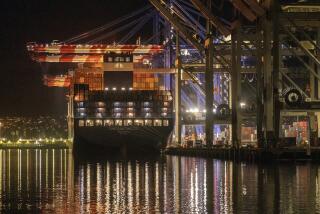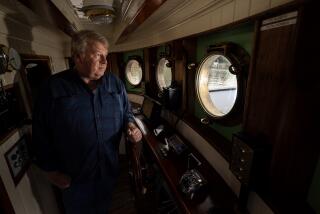Making Waves : Sea Magazine Hopes to Swamp Competition in the World of Boating
- Share via
Once upon a time, in a very wet land called Seattle, a magazine was born to serve the needs of Western boaters. The year was 1908, and the magazine eventually took the name Sea. More than 70 years later, another periodical was born, this time in a slightly drier place called Costa Mesa. It was christened Waterfront, and its focus was on Southern California.
But all wasn’t happy in the land of Western boating, and a voracious little Waterfront began eating into the profits of the venerable old Sea, which had subsequently moved south to Los Angeles.
Not long after the move, Sea’s health began to fail, and Waterfront sailed in to rescue its precursor in aquatic journalism. Publisher Duncan McIntosh Jr. was at the helm. The year was 1985.
But the tides have turned, and come June, a newly vigorous version of Sea: The Magazine of Western Boating for 80 Years will swallow Waterfront whole. The upstart journal will sink into oblivion, except for special sections in Sea tailored to the Southern California boating market. By scuttling the smaller Waterfront, McIntosh said, he can navigate Sea toward a larger share of the Western boating market.
Although both magazines were operating in the black when the merger decision was made, “we’re running 40% ahead of last year (in revenues) with Sea,” McIntosh said. “Waterfront leveled out two years ago. At that time we became our own competition. . . . We can’t be competing with ourselves.”
The moral of this story?
That it is magazine-eat-magazine out there in the boating world--a highly competitive industry that generated sales of $16.5 billion in 1987 and is the focus of about 300 newspapers, newsletters and magazines nationwide, according to the National Marine Manufacturers Assn.
The center of the boating world--including its publishing side--is on the staid East Coast, where circulation-heavy magazines such as Yachting, Power and Motoryacht, Motor Boating & Sailing, Sail, Boating, and Cruising World are harbored.
But McIntosh contends that the Western boating market is a sleeping giant, home to more wealth and marina to more big boats than any other region in the country.
Statistics provided by the National Marine Manufacturers Assn. show that California alone has more marinas--1,312--than any other state, and more manufacturers--234--of boat trailers, accessories and engines.
California has more registered boats than any state but Michigan, according to the U.S. Coast Guard. And Orange County has more such craft than any county in the state but Los Angeles, according to the state Department of Motor Vehicles.
Southern California in general--and Orange County in particular--are “Meccas for boating usage,” said Greg Proteau, director of public and financial relations for the marine manufacturers’ association.
Although California is home to more than a score of marine publications, McIntosh points out that the West is practically ignored by the Eastern yachting press, particularly the Big Six national boating magazines.
Recent statistics of Standard Rate and Data Services, the Bible of magazine circulation and advertising rates, show that Boating has only 17% of its circulation in the 13 Western states. Cruising World has only 22% there, Motor Boating & Sailing 14%, Power and Motoryacht 17%, Sail 22% and Yachting 19%.
Seventy-two percent of Sea’s subscribers reside in the West. Once its merger with Waterfront is complete, its circulation will rise to nearly 69,000, of which about 80% will be west of the Rockies, McIntosh said. Combined annual revenues of the two publications are about $4 million.
McIntosh’s mission now is to convince national boating advertisers that if they want to win the West, they can’t do it without Sea. The national magazines are fine, he said, but they do not reach a substantial number of Western boating enthusiasts.
“In the West, there are local, small tabloid publications in each harbor area,” said David Fales, advertising director of Motor Boating & Sailing, the No. 3 national boating magazine with 141,463 subscribers. “But in terms of national awareness or advertising by national advertisers, Sea is really the only publication that comes to mind.”
Compared to its competition, Sea has had a long time to anchor itself in the minds of America’s boaters. The magazine was launched in 1908 as Pacific Motor Boat, so called because founder Miller Freeman forecast a dramatic change in maritime transport with the advent of the combustion engine.
In the early 1930s, a monthly called Sea began publication in Los Angeles. Freeman bought the magazine and moved it to Seattle, where he combined it with Pacific Motor Boat to become Sea & Pacific Motor Boat. The name was later shortened to Sea, and the magazine was sold twice and moved south to Los Angeles before McIntosh bought it from Petersen Publishing in 1985.
Such celebrities as Humphrey Bogart, Cecil B. DeMille and Mack Sennett sailed through its early pages, and writers like mystery maven Erle Stanley Gardner contributed to the editorial content.
But the magazine was more than just a Who’s Who of the boating world; its pages reflected changes in technology, the flow of history and the ravages of war. The 80th anniversary edition recounts the following slices of boating life as seen in the magazine’s glossy pages:
- 1918: The U.S. Shipping Board asks American men to help in World War I shipbuilding efforts. “The slimy German submarine has already sunk approximately 10% of the ships afloat at the beginning of the war,” the magazine said. “Think of it! Yes, one in every 10 has gone down before the devilish cunning of the Hellish Hun.”
- 1933: The demise of Prohibition brings an end to Coast Guard sweeps of the West Coast in search of rum runners.
- 1942: In a strong editorial endorsement of Japanese internment, Freeman encourages all Americans of Japanese descent to denounce the country of their ancestors. “Let the loyal drive out those who bring shame upon them by traitorous activities,” he wrote.
- 1948: Then-Gov. Earl Warren fires the starting gun at the Newport Ocean Sailing Assn.’s first Newport-to-Ensenada race.
- 1970: Newport Beach sailor Bill Ficker wins the America’s Cup.
In its 80 years, the magazine also endured slumps in the boating industry caused by the Depression, World War II and the economic uncertainty of the late 1970s and early 1980s. Between those lows, retail spending on boating rose unchecked. That kind of consumer confidence is now returning.
Boom Times Returning
“The early 1970s were considered the boom years in boating,” Proteau said. “There was a happy economy, plenty of fuel, people were getting more interested in recreation. A lot of those things are repeating themselves today.”
Industry experts contend that this rise in boating’s fortunes has spawned a corresponding increase in marine periodicals. Proteau estimates that the number of titles has grown from an estimated 200 in 1986 to about 300 today.
To Fales of Motor Boating & Sailing, that means that the race for advertisers is increasingly tough. “I see the proliferation of titles rather than a loss of titles,” Fales said. “It’s extremely competitive. When we present our ad pitch to non-marine clients, they remark how competitive we are compared to the regular magazines that call on them.”
The industry boom also is reflected in the profile of Sea’s average reader--a man who seems destined to fulfill advertisers’ wildest dreams. The Sea man--and marketing surveys show that the average reader is most likely to be male--is 49 years old, has a college degree, has been boating for more than 10 years, owns his own home and 2 1/2 boats, and has a household income of $88,000.
He’ll Need the Money
Chances are he will need to be that well-heeled, for he probably spends more on the care and feeding of his boats than many families spend on their homes. The average 35- to 40-foot boat, says McIntosh, costs an easy $200,000 new; slip fees can reach $500 each month, and then there is insurance.
One of the goals of Sea magazine’s new incarnation is to widen its readership beyond the corporate cruiser, to reach that part of the population that needs to spend its potential slip fees on mortgage payments.
“We need some more new blood,” McIntosh said. “We’re very interested in getting entry-level people in here. The message we have to get out is that you can tailor boating to your income.”
While McIntosh insists that the coming merger will improve Sea magazine and increase profits, not everyone in the industry agrees that he can pull it off. One critic is David Poe, whose Huntington Beach-based magazine Santana focuses on Southern California and competed with the defunct Waterfront.
To Poe, Sea’s “macro-regional” approach--covering the 13 Western states instead of just the Pacific Coast--makes it difficult for advertisers.
“It’s kind of a weird hybrid,” Poe said. “Duncan turned it into a macro-regional. Then he merged Waterfront to it. We in the community are wondering what the hell he’s doing.”
NATIONAL BOATING MAGAZINES BY CIRCULATION
Name Description Headquarters Circulation Boating General interest magazine New York 188,057 for powerboat enthusiasts Sail General interest magazine Charlestown, 175,212 for sailors Mass. Motor Boating General interest magazine New York 141,463 & Sailing for sailors and powerboaters Yachting General interest magazine New York 136,028 for sailors and powerboaters Power and For owners of powerboats Stamford, 135,319 Motoryacht 24’ and over Conn. Cruising World For those who enjoy Newport, 127,073 cruising under sail R.I.
LARGER WESTERN-BASED MAGAZINES
Name Description Headquarters Circulation Trailer Boats For those who own crafts Carson 100,000 trailered behind the family car Powerboat Performance boating Van Nuys 83,224 Hot Boat General powerboating Corona 92,364 The Log Southern California San Diego 46,960 Sea Magazine Western boating Costa Mesa 69,000 (with Waterfront) Personal General interest Long Beach 65,500 Watercraft Illustrated The Western General Western boating Carson 23,961 Boatman
Source: Standard Rate and Data Services, March 27, 1988
More to Read
Sign up for The Wild
We’ll help you find the best places to hike, bike and run, as well as the perfect silent spots for meditation and yoga.
You may occasionally receive promotional content from the Los Angeles Times.







